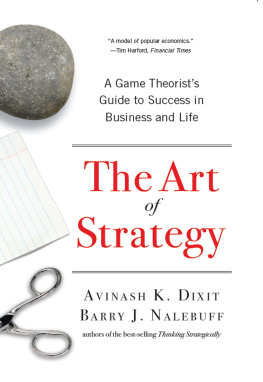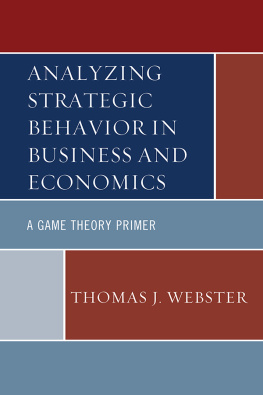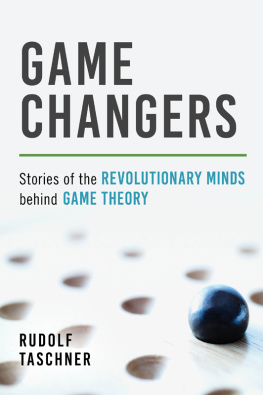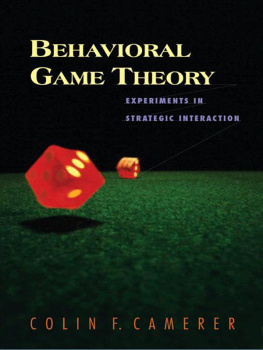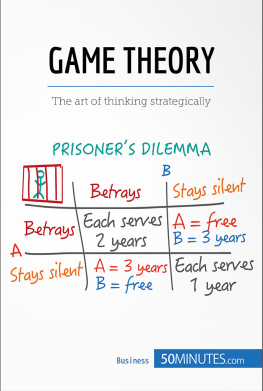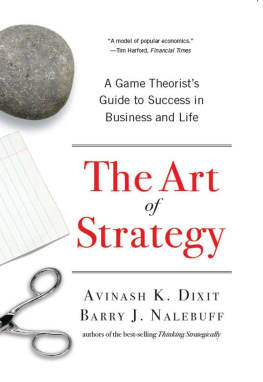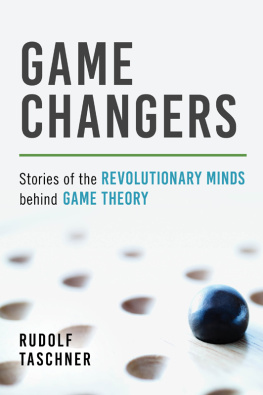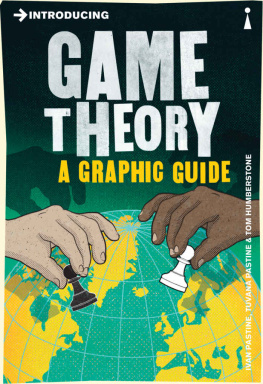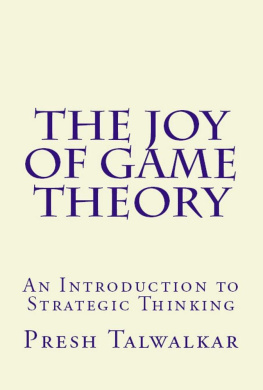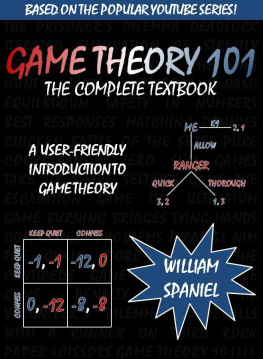Also by
AVINASH K. DIXIT &
BARRY J. NALEBUFF
Lawlessness and Economics: Alternative Modes of Governance (Gorman Lectures in Economics, University College London)
by Avinash K. Dixit
Investment Under Uncertainty
by Avinash K. Dixit & Robert S. Pindyck
Thinking Strategically
by Avinash Dixit & Barry J. Nalebuff
Co-opetition
by Adam Brandenburger & Barry J. Nalebuff
Why Not?
by Ian Ayres & Barry J. Nalebuff
The Art of Strategy
A GAME THEORISTS
GUIDE TO SUCCESS
IN BUSINESS & LIFE
Avinash K. Dixit
Barry J. Nalebuff

W. W. NORTON & COMPANY
New York London
Copyright 2008 by Avinash K. Dixit and Barry J. Nalebuff
All rights reserved
Doonesbury cartoon: 1993 G. B. Trudeau. Reprinted with permission of
Universal Press Syndicate. All rights reserved.
Peanuts cartoon: United Features Syndicate, Inc.
For information about permission to reproduce selections from this book,
write to Permissions, W. W. Norton & Company, Inc.
500 Fifth Avenue, New York, NY 10110
Library of Congress Cataloging-in-Publication Data
Dixit, Avinash K.
The art of strategy : a game theorist's guide to success in business & life / Avinash K. Dixit, Barry J. Nalebuff.1st ed.
p. cm.
Includes bibliographical references and index.
ISBN: 978-0-393-06995-2
1. Strategic planning. 2. Strategy. 3. Game theory.
4. Decision making. I. Nalebuff, Barry, 1958II. Title.
HD30.28.D587 2008
658.4'012dc22
2008021347
W. W. Norton & Company, Inc.
500 Fifth Avenue, New York, N.Y. 10110
www.wwnorton.com
W. W. Norton & Company Ltd.
Castle House, 75/76 Wells Street, London W1T 3QT
To all our students,
from whom we have learned so much
(especially Seth BJN)
CONTENTS
Preface
W E DIDNT SET out to write a new book. The plan was simply to revise our 1991 book, Thinking Strategically. But it didnt quite turn out that way.
One model for writing a revision comes from Borgess character Pierre Menard, who decides to rewrite Cervantess Don Quixote. After great effort, Menards revision ends up being word-for-word identical to the original. However, 300 years of history and literature have passed since Quixote, including Quixote itself. Although Menards words are the same, his meaning is now entirely different.
Alas, our original text wasnt Don Quixote, and so the revision did require changing a few words. In fact, most of the book is entirely new. There are new applications, new developments in the theory, and a new perspective. So much is new that we decided a new title was called for as well. Although the words are new, our meaning remains the same. We intend to change the way you see the world, to help you think strategically by introducing the concepts and logic of game theory.
Like Menard, we have a new perspective. When we wrote Thinking Strategically, we were younger, and the zeitgeist was one of self-centered competition. We have since come to the full realization of the important part that cooperation plays in strategic situations, and how good strategy must appropriately mix competition and cooperation.
We started the original preface with: Strategic thinking is the art of outdoing an adversary, knowing that the adversary is trying to do the same to you. To this we now add: It is also the art of finding ways to cooperate, even when others are motivated by self-interest, not benevolence. It is the art of convincing others, and even yourself, to do what you say. It is the art of interpreting and revealing information. It is the art of putting yourself in others shoes so as to predict and influence what they will do.
We like to think that The Art of Strategy includes this older, wiser perspective. But there is also continuity. Even though we offer more real-life stories, our purpose remains to help you develop your own ways of thinking about the strategic situations you will face; this is not an airport book offering seven steps for sure strategic success. The situations you face will be so diverse that you will succeed better by knowing some general principles and adapting them to the strategic games you are playing.
Businessmen and corporations must develop good competitive strategies to survive, and find cooperative opportunities to grow the pie. Politicians have to devise campaign strategies to get elected and legislative strategies to implement their visions. Football coaches plan strategies for players to execute on the field. Parents trying to elicit good behavior from children must become amateur strategiststhe children are pros.
Good strategic thinking in such numerous diverse contexts remains an art. But its foundations consist of some simple basic principlesan emerging science of strategy, namely game theory. Our premise is that readers from a variety of backgrounds and occupations can become better strategists if they know these principles.
Some people question how we can apply logic and science to a world where people act irrationally. It turns out that there is often method to the madness. Indeed, some of the most exciting new insights have come from recent advances in behavioral game theory, which incorporates human psychology and biases into the mix and thus adds a social element to the theory. As a result, game theory now does a much better job dealing with people as they are, rather than as we might like them to be. We incorporate these insights into our discussions.
While game theory is a relatively young sciencejust over seventy years oldit has already provided many useful insights for practical strategists. But, like all sciences, it has become shrouded in jargon and mathematics. These are essential research tools, but they prevent all but the specialists from understanding the basic ideas. Our main motive for writing Thinking Strategically was the belief that game theory is too interesting and important to leave to the academic journals. The insights prove useful in many endeavorsbusiness, politics, sports, and everyday social interactions. Thus we translated the important insights back into English and replaced theoretical arguments with illustrative examples and case studies.
We are delighted to find our view becoming mainstream. Game theory courses are some of the most popular electives at Princeton and Yale, and most other schools where they are offered. Game theory permeates strategy courses in MBA programs, and a Google search for game theory produces more than 6 million pages. Youll find game theory in newspaper stories, op-eds, and public policy debates.
Of course, much of the credit for these developments belongs to others: to the Economics Nobel Prize Committee, which has awarded two prizes in game theoryin 1994, to John Harsanyi, John Nash, and Reinhard Selten and in 2005, to Robert Aumann and Thomas Schelling; to Sylvia Nasar, who wrote A Beautiful Mind, the best-selling biography of John Nash; to those who made the award-winning movie of the same name; and to all those who have written books popularizing the subject. We might even share a bit of the credit. Since publication, Thinking Strategically has sold 250,000 copies. It has been translated into numerous languages, and the Japanese and Hebrew translations have been best sellers.
We owe a special debt to Tom Schelling. His writings on nuclear strategies, particularly The Strategy of Conflict and Arms and Influence, are justly famous. In fact, Schelling pioneered a lot of game theory in the process of applying it to nuclear conflict. Michael Porters Competitive Strategy, drawing on the lessons of game theory for business strategy, is equally important and influential. An annotated guide to the works of Schelling, Porter, and many others is provided in our Further Reading section.

